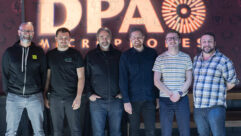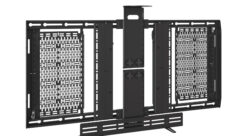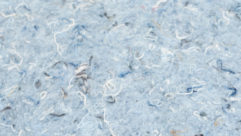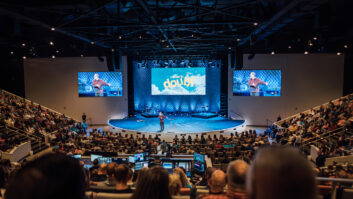Sound American-style, in the UKThe Whitewell Metropolitan Church has one of the firstlarge-scale sound-system designs created in the United Kingdom.
Nov 20, 1996 12:00 PM,
David NealeNeale is head of David Neale Associates, London, England.
The concept of worship sound systems is long established in the United States. In Europe it is something that has taken a long time to become understood, let alone recognized and implemented. Most American churches have some kind of audio setup; the bigger places of worship can have rigs some touring rock bands would covet, while even medium-sized chapels will be equipped with something adequate enough for a small, live-musical group.
Europe is different, both in the type of building and the services. Many churches are centuries old and not suited to the installation of modern sound systems, and the type of evangelical service that uses large choirs and elaborate instrumentation is still in the minority in churches in Europe.
It is changing, albeit at a slow rate. Although the Anglican and Catholic churches have to work carefully around the sometimes ancient interiors of their buildings, the less conventional orders are discovering the flexibility of specifically built worship sites that can sustain the latest in audio technology.
The Whitewell Metropolitan Church in Belfast, Northern Ireland, which opened in 1994, was modeled very much on American lines – the church elders visited the Second Baptist Church in Houston, TX, for a different kind of inspiration.
Their mission was to build a replacement for the original Whitewell church, which had seen the congregation grow to such an extent that the 1,200-person-capacity hall had standing room only. Out of its own funds, the church embarked on building a new place of worship that now accommodates 3,400 people and at the time was called the largest free standing construction of its kind in Europe.
Explaining the reasons for such a huge undertaking, Pastor Norman Hobson said, “We had the opportunity to build a big church and put in the kind of equipment that we needed. We could have continued with the old church – it was a good sound, but not all the choir was amplified and neither were the drums. With the new church, we knew we needed a bigger capacity mixer because of the channels involved if we were going to mic everything, but there was nothing in the province or on mainland England that measured up to what we had in mind.”
Charting a new courseHence the visit to Texas, where the pastor saw what could be done with a comprehensive sound system and a large number of musicians. Music is important at Whitewell. Various bands play during the services, supported by choirs, which can number up to 180 members.
This obviously called for something more than just a lectern mic and an amplifier on the electronic organ. In fact, Whitewell has gone past most people’s ambitions by installing the biggest Soundcraft Vienna console ever built and a large EAW rig. All of this is supported by RCF infill and ceiling loudspeakers and a rack of processing equipment most rock and roll engineers would kill for – in the spiritual sense, of course.
As well as having a clear idea of what they wanted to do, the Whitewell elders had the advantage of inside expertise, with many of the congregation members employed at either BBC Northern Ireland or in the electronics trade. However, a full-time sound contractor was still required, and the job eventually went to Randalstown-based Walker Audio, run by ex-BBC engineer Karl Walker, who was initially asked to quote on just the main sanctuary of the church. The work later expanded from there and took in a recording studio and a video edit suite, both in the upstairs of the building.
“They wanted ideas and outlined costs because we were just talking about the PA at the time,” said Walker. “In the early stages they wanted a fairly dry acoustic because they knew the type of music to be played. During the performance it is up to the operators to add any EQ. All we had were copies of the plans, and it was hard to visualize how it was going to turn out because there was very little like it.”Building work had started in November 1991 but it wasn’t until September 1993 that Walker and his installers got on site. Time was tight, but the situation was helped by having most of the cabling, which now measures seven and a half miles (12 km), already in place. What had to be settled, however, was the specific equipment to be installed.
Nailing down the detailsWalker had spoken to Ken Berger, president of EAW, at the 1992 PLASA (Professional Lighting and Sound Association) trade show in London about using the then new MH662. “It became apparent that it would fulfill all the needs without going down the route of long-thrown horns,” Walker said.
The main sound system was conceived as a centrally flown cluster. The finished product houses the sub-bass cabinets, something forced on the installers as the design of the church restricted where these could be placed. “The main requirement was for a fairly high SPL and for the system to go down to 20 Hz but still be dynamic enough to handle kick drums,” Walker said.
EAW’s vice president of engineering, Kenton Forsythe, was brought in to consult on the project and, with Walker, concluded that as long as the acoustics were right, most long-throw units would work in the situation. Forsythe then proposed two configurations: one with a four-way system, which was rejected, the other with the central cluster that now hangs in the middle of the sanctuary. This is made up of three BV535 long excursion boxes containing vented 3—15s and three MH662s, which cover the gallery.
“It was important to get plenty of length on the cluster, particularly in the gallery section, because the back of this is 96 feet (29 m) away from the cluster,” Walker said.
The MH662s contain 2—10 units with a two inch (51 mm) 500E horn from the E series. Hung on the bottom of the central rig are two RCF 9040 horns. These were added after the cluster had to be raised above its original height to keep it out of sight lines.
“The bottom four rows were not being properly covered, especially up to 900 Hz, which meant most of the high end was being lost,” Walker said. He added that the first four rows are particularly important because visiting dignitaries are normally seated there. The RCFs, like the rest of the rig, are painted white. They run on their own amplifiers and have separate crossovers and EQ from the EAW cabinets.
Enhanced stereo and extra width for the audio picture is added by having a pair of EAW JS260s on either side of the main system, creating what Walker called a nice ambient acoustic. To give an even coverage under the long balcony, 12 RCF PL80 ceiling loudspeakers were installed.
If this main system is reminiscent of a rock and roll concert, then the stage setup is even more so. As the majority of instruments played by the various band, which cover most styles from rock to gospel, are amplified, both the musicians and the singers need monitoring facilities. According to Walker, monitoring had to be approached carefully: “With 180 plus people in the choir and the various musicians, we couldn’t just blast out the foldback, because it would color the recordings.”
To this end he used 18 RCF Monitor 4Ts suspended above the choir, wired in 100 V line. “This kept the cost down on amplification because we’re only using one side of a JBL MPA1100, which runs in at 1.5 kHz a side. This feeds two 100V line transformers. The frequency response of the 4Ts is wide enough to allow for pianos and similar instruments to be put through them. Because the sound is distributed above the heads of the choir, there is very little coloration,” Walker said.
Another cabinet in the Monitor series, the 8, is used for floor monitoring. Each section of the band has its own eight-way monitor mixer feeding the individual wedges. All this is powered by a TOA P1060 amplifier. This setup allows each of the players to monitor on the loudspeakers or through headphones, which take their feed from specially designed mix boxes. These also give talkback to and from the stage and control room. Monitor feeds come from the eight audio outputs of the VCA panel on the Soundcraft Vienna.
Amplification for the sanctuary system is provided by JBL MPA1100 and TOA P10/D1100 units. The D1100s power the under-gallery delays. To give the pastors as much freedom as possible during the services, they are fitted with Sennheiser SK2012 wireless microphones; a handheld VHF 1081 is available for other situations. Because the preachers have a tendency to become animated during their sermons and may move about, there is a danger of howl-round. To guard against this, a Sabine feedback exterminator has been linked into the system.
Elsewhere in the church are 148 microphone points, which all run back to a patchbay under the front-of-house desk. Normal services require around 70 channels, which can be done without re-patching.
A custom solutionSuch a large number of incoming signals meant a substantial main console was required. Walker spent many hours examining what was on the market. Although Walker was looking at many points, including better EQ, direct outs and variable gain control, the VCA section was deemed the most important feature. “With this you can control the whole desk in one operation,” Walker said.
Walker decided that the Soundcraft Vienna had all these facilities but, as with most other desks, did not offer the large number of channels required by the application. Using two of the units was a possibility because the Vienna is built to be linked, with two sets of VCAs and two operators. However, Walker was opposed to having two Viennas side-by-side. The goal was to have just one operator on one desk.
The solution was to approach the specials department of Soundcraft and request the biggest Vienna ever. This 80-input version was shipped to Belfast in two sections and reassembled. The 80 inputs are split from the desk, with one group routed to the recording studio, the centerpiece of which is a 52-channel Soundcraft Sapphyre, linked to the Soundcraft 600 that used to be the main desk in Whitewell’s old home.
Another 10 congregation choir mics are fed to the studio, giving a total of 96 mixable sources. The services are recorded onto DAT for later duplication onto cassette. These recordings are for the church’s own archive and for sale to both church members and overseas congregations.
A new styleWalker observed that some may think the mixture of pro audio and 100 V line equipment was strange, but it was done for a good reason. “It was done to get even coverage. Also, if I’d gone for low impedance throughout, the costs would have been astronomical.”The Whitewell Metropolitan Church has been called one of the largest European church systems and has led Walker to quote on a number of other, similar projects, this time in Scotland and England. With this kind of activity, Europe could soon find itself moving away from the cozy parish image and toward a bolder American style.










